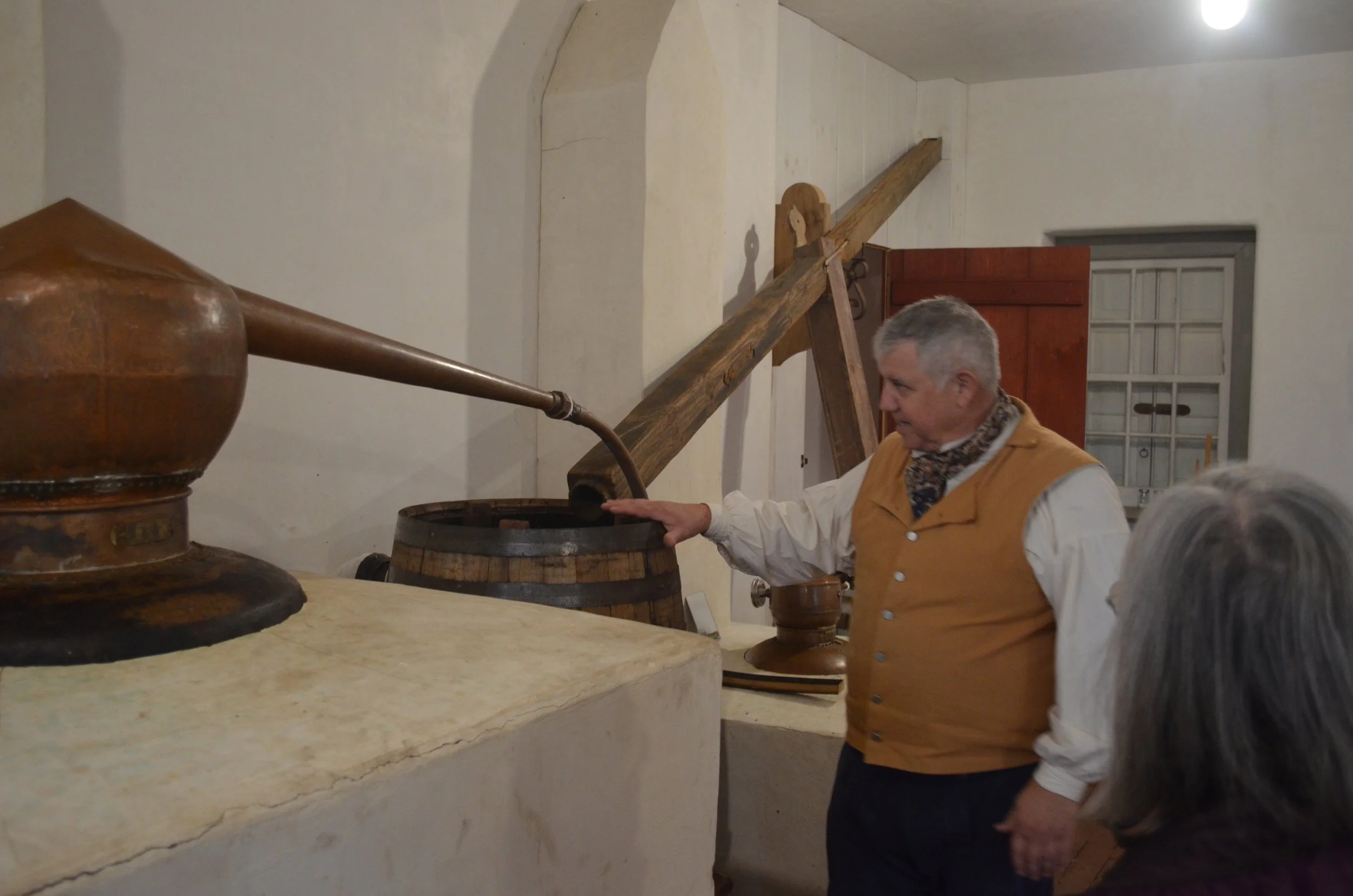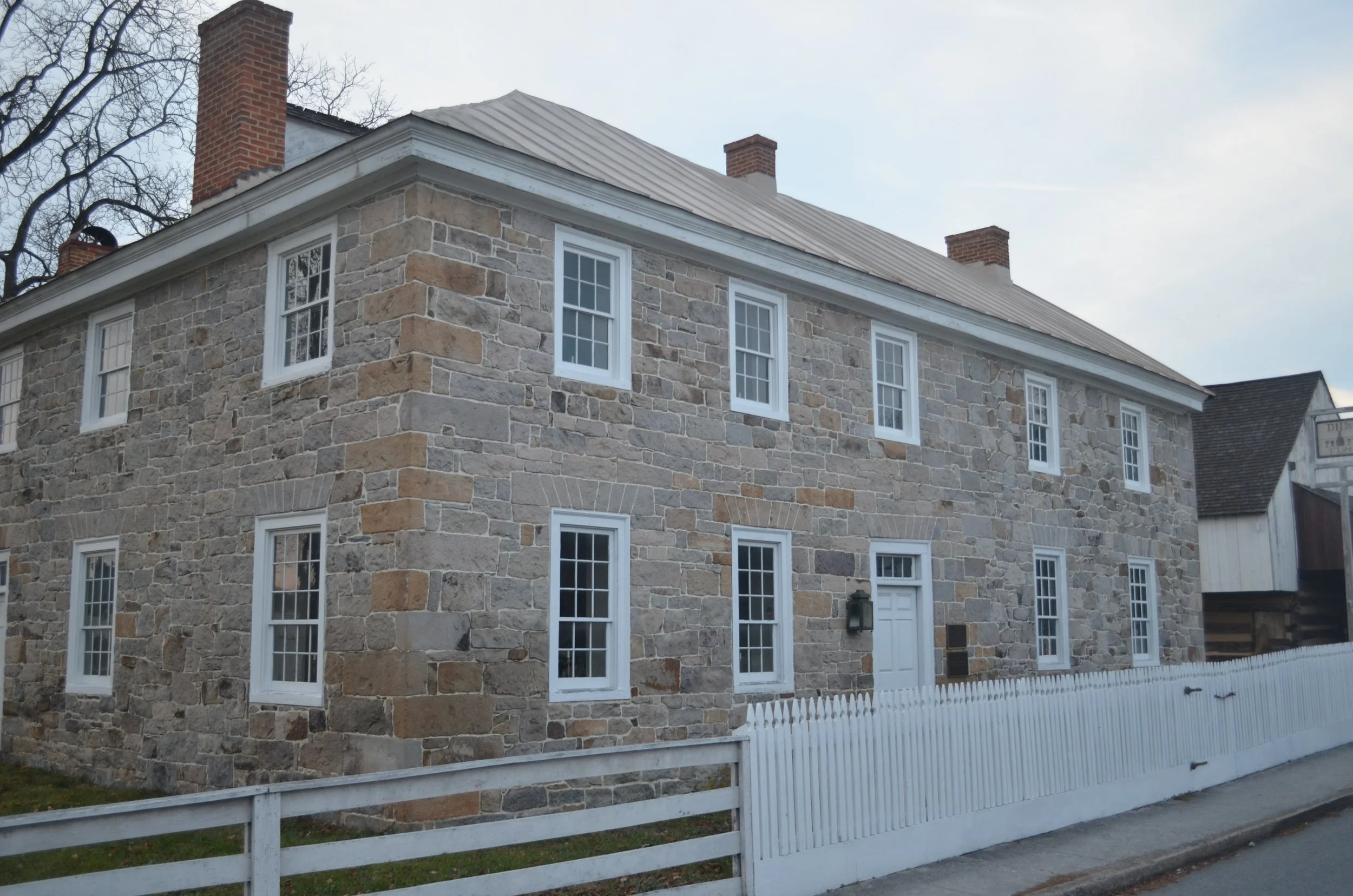Traveling to History: Thirty
EICHELBERGER’S DISTILLERY IN DILLSBURG, PA
Making Rye Whiskey the 19th-Century Way
By James F. Lee
“Mary,” one of the stills at the Eichelberger Distillery in Dillsburg, PA. (Photo Credit: Gettysburg Images for Dills Tavern, Eichelberger Distillery)
We sat at a long wooden table in the tap room of the Eichelberger Distillery at Dills Tavern as our guide James Nellis handed us each a toddy to sample, a simple drink of hot water, honey, lemon, cinnamon, and brandy.
Although the taproom fireplace was cold on the day of our visit, the hot toddy took out the November chill.
Eichelberger Distillery, located on the grounds of Dills Tavern in Dillsburg, PA, is a solid stone structure built in 1794 at a crossroads in what was then the Pennsylvania frontier. The distillery is a recently built newcomer opened in 2024.
Both the tavern and the distillery are owned and operated by the Northern York County Historical and Preservation Society (NYCHAPS).
Guide James Nellis stands at the entrance of the Eichelberger Distillery. Note that the stone walls of the building are composed of sandstone repurposed from a barn circa 1810. (Photo by James F. Lee)
James Nellis explains the process of distilling during a tour of the Eichelberger Distillery. He stands in front of “Mary,” the larger of the two stills on the premises. (Photo by James F. Lee)
In creating this two-room distillery, NYCHAPS took great pains to maintain historic integrity for what a late-18th-century structure would look like. The roof is made of cedar shingles nailed on wooden lath attached to fir rafters. Repurposed sandstone from a circa 1810 barn was used for the outer walls. On distilling days, an enormous 11-foot-wide fireplace heats the taproom, where we sampled our hot toddies. Cast iron doors open to fireboxes on the rear wall of the fireplace, heating the copper pots on the distillery side of the building.
Pennsylvania was the center for distilling in the colonial period and early years of the country. In York County alone, 220 taxable stills operated in 1783, and that’s not accounting for the hidden ones!
After we sampled our hot toddy, James poured us a cherry bounce, a favored drink of George Washington’s. At Eichelberger’s, the distiller uses Martha Washington’s own recipe of pitted, mashed cherries sweetened with sugar, brandy and infused with cinnamon and cloves. This current batch of bounce came from cherries grown on a nearby farm.
A bottle of Eichelberger’s Old Monaghan rye whiskey at the tasting table in the distilling room. (Photo by James F. Lee)
James handed us a small metal grater with a stick of nutmeg to add to our drinks for extra flavor. Sweet and spicy, it was perfect to sip in front of a warm fire, and just the kind of drink 18th-century travelers might take while spending the night at Dills Tavern.
“We like to say it tastes like Christmas,” said James.
After sampling our drinks, we made our way to the distilling room. Here we learned that Eichelberger’s makes rye whiskey using a recipe that dates from 1809, using two copper pot stills heated by wood fires. The copper kettles aren’t visible because they are encased in brick and plaster, but we could see extending from each still a long swan-neck copper arm, the function of which we would learn later.
People like to give names to inanimate objects, and this is no different at Eichelberger’s. The larger of the two stills is named Mary in honor of Mary Dill, the wife of Matthew Dill, original owner of the land on which Dills Tavern sits. The other, Catherine, was one of the children of Leonard Eichelberger, a later owner of Dills Tavern, who built a distillery nearby.
The process of distilling is a complicated one, and we will give the simple version here. First, grains are soaked in water, and yeast is added to help fermentation to produce a mash. These grains can be corn, rye, or barley, in any combination, depending on what is being produced. At Eichelberger’s at least 60 percent of the grain is rye, and about 30 percent corn, producing rye whiskey.
James points out that rye whiskey tastes more earthy and peppery than bourbon, which uses corn as the primary grain.
The rye mash is put in Mary, the larger copper still, and heated from below by a wood fire. Vapors pass along the copper arm and are collected in a container as a liquid. This product is then heated in Catherine, the smaller still, where higher concentrations of alcohol can be achieved.
Murray Small, a Board Member of NYCHAPS, said that the distillery is transitioning to using only local grains, and hopes at some point to use Indian corn in the mix.
A group tasting in the taproom of Eichelberger Distillery. (Photo Credit: Gettysburg Images for Dills Tavern, Eichelberger Distillery)
Clair Zeiders, a carpenter/woodworker at the Wheelwright Shop at Dills Tavern, shows a documents box he made. (Photo by James F. Lee)
The distillery opened last year after a 15-year planning and construction process. The goal is to produce a rye whisky called Old Monaghan for sale to the public by bottle.
Eichelberger’s Distillery is open year-round Mon.-Fri. by appointment. Call 717-502-1440. Tours are Sat. 12-3, and Sunday 1-3. Cost $10. The distillery is also open Wed. evenings 3-7. Check website for details.
Dills Tavern is open for tours from April to November. In addition, the property contains a wheelwright shop, a large German barn from 1798, and outdoor oven and smoke house, and the distillery.
Nearby, the NYCHPS owns and maintains Maple Shade Barn, which has been restored and houses a museum and the organization’s archives.
Throughout the year, the tavern hosts a First Friday Series, a different theme every month, centered on music and drink. Past and future events have included wassailing in the moonlight, toasting St. Patrick’s Day, and celebrating Scots Irish heritage with live bluegrass. Check the website for upcoming events.
Dills Tavern in Dillsburg, PA. The original tavern, on the right side of the building, dates from 1794. Today NYCHAPS conducts tours in the tavern. (Photo by James F. Lee)
A docent shows a dining area during a tour of Dills Tavern. (Photo by James F. Lee)








